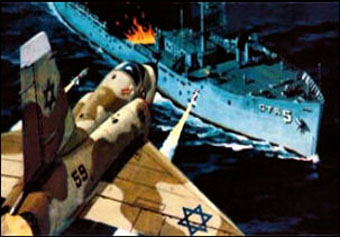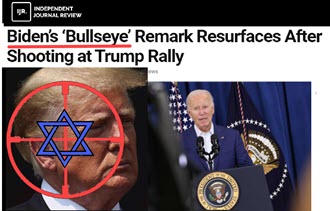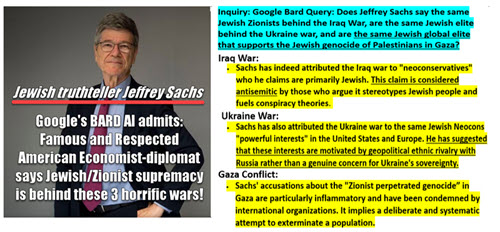 New Revelations in Attack on American Spy Ship
New Revelations in Attack on American Spy Ship
Veterans, documents suggest U.S., Israel didn’t tell full story of deadly ’67 incident
By John Crewdson (Exerpt below)
…Yiftah Spector, the first Israeli pilot to attack the ship, told the Jerusalem Post in 2003 that when he first spotted the Liberty, “I circled it twice and it did not fire on me. My assumption was that it was likely to open fire at me and nevertheless I slowed down and I looked and there was positively no flag.”
But the Liberty crewmen interviewed by the Tribune said the Israeli jets simply appeared and began shooting. They also said the Liberty did not open fire on the planes because it was armed only with four .50-caliber machine guns intended to repel boarders.
“I can’t identify it, but in any case it’s a military ship,” Spector radioed his ground controller, according to a transcript of the Israeli air-to-ground communications published by the Jerusalem Post in 2004.
That transcript, made by a Post reporter who was allowed to listen to what the Israeli Air Force said were tapes of the attacking pilots’ communications, contained only two references to “American” or “Americans,” one at the beginning and the other at the end of the attack.
The first reference occurred at 1:54 p.m. local time, two minutes before the Israeli jets began their first strafing run.
In the Post transcript, a weapons system officer on the ground suddenly blurted out, “What is this? Americans?”
“Where are Americans?” replied one of the air controllers.
The question went unanswered, and it was not asked again.
Twenty minutes later, after the Liberty had been hit repeatedly by machine guns, 30 mm cannon and napalm from the Israelis’ French-built Mirage and Mystere fighter-bombers, the controller directing the attack asked his chief in Tel Aviv to which country the target vessel belonged.
“Apparently American,” the chief controller replied.
Fourteen minutes later the Liberty was struck amidships by a torpedo from an Israeli boat, killing 26 of the 100 or so NSA technicians and specialists in Russian and Arabic who were working in restricted compartments below the ship’s waterline.
Analyst: Israelis wanted it sunk
The transcript published by the Jerusalem Post bore scant resemblance to the one that in 1967 rolled off the teletype machine behind the sealed vault door at Offutt Air Force Base in Omaha, where Steve Forslund worked as an intelligence analyst for the 544th Air Reconnaissance Technical Wing, then the highest-level strategic planning office in the Air Force.
“The ground control station stated that the target was American and for the aircraft to confirm it,” Forslund recalled. “The aircraft did confirm the identity of the target as American, by the American flag.
“The ground control station ordered the aircraft to attack and sink the target and ensure they left no survivors.”
Forslund said he clearly recalled “the obvious frustration of the controller over the inability of the pilots to sink the target quickly and completely.”
“He kept insisting the mission had to sink the target, and was frustrated with the pilots’ responses that it didn’t sink.”
Nor, Forslund said, was he the only member of his unit to have read the transcripts. “Everybody saw these,” said Forslund, now retired after 26 years in the military.
Forslund’s recollections are supported by those of two other Air Force intelligence specialists, working in widely separate locations, who say they also saw the transcripts of the attacking Israeli pilots’ communications.
One is James Gotcher, now an attorney in California, who was then serving with the Air Force Security Service’s 6924th Security Squadron, an adjunct of the NSA, at Son Tra, Vietnam.
“It was clear that the Israeli aircraft were being vectored directly at USS Liberty,” Gotcher recalled in an e-mail. “Later, around the time Liberty got off a distress call, the controllers seemed to panic and urged the aircraft to ‘complete the job’ and get out of there.”
Six thousand miles from Omaha, on the Mediterranean island of Crete, Air Force Capt. Richard Block was commanding an intelligence wing of more than 100 analysts and cryptologists monitoring Middle Eastern communications.
The transcripts Block remembered seeing “were teletypes, way beyond Top Secret. Some of the pilots did not want to attack,” Block said. “The pilots said, ‘This is an American ship. Do you still want us to attack?’
“And ground control came back and said, ‘Yes, follow orders.'”
Gotcher and Forslund agreed with Block that the Jerusalem Post transcript was not at all like what they remember reading.
“There is simply no way that [the Post transcript is] the same as what I saw,” Gotcher said. “More to the point, for anyone familiar with air-to-ground [communications] procedures, that simply isn’t the way pilots and controllers communicate.”
Block, now a child protection caseworker in Florida, observed that “the fact that the Israeli pilots clearly identified the ship as American and asked for further instructions from ground control appears to be a missing part of that Jerusalem Post article.”
Arieh O’Sullivan, the Post reporter who made the newspaper’s transcript, said the Israeli Air Force tapes he listened to contained blank spaces. He said he assumed those blank spaces occurred while Israeli pilots were conducting their strafing runs and had nothing to communicate.
‘But sir, it’s an American ship!’
Forslund, Gotcher and Block are not alone in claiming to have read transcripts of the attack that they said left no doubt the Israelis knew they were attempting to sink a U.S. Navy ship.
Many ears were tuned to the battles being fought in and around the Sinai during the Six-Day War, including those belonging to other Arab nations with a keen interest in the outcome.
“I had a Libyan naval captain who was listening in that day,” said a retired CIA officer, who spoke on condition that he not be named discussing a clandestine informant.
“He thought history would change its course,” the CIA officer recalled. “Israel attacking the U.S. He was certain, listening in to the Israeli and American comms [communications], that it was deliberate.”
The late Dwight Porter, the American ambassador to Lebanon during the Six-Day War, told friends and family members that he had been shown English-language transcripts of Israeli pilots talking to their controllers.
A close friend, William Chandler, the former head of the Trans-Arabian Pipe Line Co., said Porter recalled one of the pilots protesting, “But sir, it’s an American ship — I can see the flag!’ To which the ground control responded, ‘Never mind; hit it!'”
Porter, who asked that his recollections not be made public while he was alive because they involved classified information, also discussed the transcripts during a lunch in 2000 at the Cosmos Club in Washington with another retired American diplomat, Andrew Kilgore, the former U.S. ambassador to Qatar.
Kilgore recalled Porter saying that he “saw the telex, read it, and passed it right back” to the embassy official who had shown it to him. He quoted Porter as recalling that the transcript showed “Israel was attacking, and they know it’s an American ship.”
Haviland Smith, a young CIA officer stationed in Beirut during the Six-Day War, said that although he never saw the transcript, he had “heard on a number of occasions exactly the story that you just told me about what that transcript contained.”
He had later been told, Smith recalled, “that ultimately all of the transcripts were deep-sixed. I was told that they were deep-sixed because the administration did not wish to embarrass the Israelis.”
Perhaps the most persuasive suggestion that such transcripts existed comes from the Israelis themselves, in a pair of diplomatic cables sent by the Israeli ambassador in Washington, Avraham Harman, to Foreign Minister Abba Eban in Tel Aviv.
Five days after the Liberty attack, Harman cabled Eban that a source the Israelis code-named “Hamlet” was reporting that the Americans had “clear proof that from a certain stage the pilot discovered the identity of the ship and continued the attack anyway.”
Harman repeated the warning three days later, advising Eban, who is now dead, that the White House was “very angry,” and that “the reason for this is that the Americans probably have findings showing that our pilots indeed knew that the ship was American.”
According to a memoir by then-CIA director Richard Helms, President Johnson’s personal anger was manifest when he discovered the story of the Liberty attack on an inside page of the next day’s New York Times. Johnson barked that “it should have been on the front page!”
Israeli historian Tom Segev, who mentioned the cables in his recent book “1967,” said other cables showed that Harman’s source for the second cable was Arthur Goldberg, then U.S. ambassador to the United Nations.
The cables, which have been declassified by the Israelis, were obtained from the Israeli State Archive and translated from Hebrew by the Tribune.
Oliver Kirby, the NSA’s deputy director for operations at the time of the Liberty attack, confirmed the existence of NSA transcripts.
Asked whether he had personally read such transcripts, Kirby replied, “I sure did. I certainly did.”
“They said, ‘We’ve got him in the zero,'” Kirby recalled, “whatever that meant — I guess the sights or something. And then one of them said, ‘Can you see the flag?’ They said ‘Yes, it’s U.S, it’s U.S.’ They said it several times, so there wasn’t any doubt in anybody’s mind that they knew it.”
Kirby, now 86 and retired in Texas, said the transcripts were “something that’s bothered me all my life. I’m willing to swear on a stack of Bibles that we knew they knew.”
One set of transcripts apparently survived in the archives of the U.S. Army’s intelligence school, then located at Ft. Holabird in Maryland.
W. Patrick Lang, a retired Army colonel who spent eight years as chief of Middle East intelligence for the Defense Intelligence Agency, said the transcripts were used as “course material” in an advanced class for intelligence officers on the clandestine interception of voice transmissions.
“The flight leader spoke to his base to report that he had the ship in view, that it was the same ship that he had been briefed on and that it was clearly marked with the U.S. flag,” Lang recalled in an e-mail.
“The flight commander was reluctant,” Lang said in a subsequent interview. “That was very clear. He didn’t want to do this. He asked them a couple of times, ‘Do you really want me to do this?’ I’ve remembered it ever since. It was very striking. I’ve been harboring this memory for all these years.”
Key NSA tapes said missing
Asked whether the NSA had in fact intercepted the communications of the Israeli pilots who were attacking the Liberty, Kirby, the retired senior NSA official, replied, “We sure did.”
On its Web site, the NSA has posted three recordings of Israeli communications made on June 8, 1967. But none of the recordings is of the attack itself.
Indeed, the declassified documents state that no recordings of the “actual attack” exist, raising questions about the source of the transcripts recalled by Forslund, Gotcher, Block, Porter, Lang and Kirby.
The three recordings reflect what the NSA describes as “the aftermath” of the attack — Israeli communications with two Israeli helicopters dispatched to rescue any survivors who may have jumped into the water.
Two of the recordings were made by Michael Prostinak, a Hebrew linguist aboard a U.S. Navy EC-121, a lumbering propeller-driven aircraft specially equipped to gather electronic intelligence.
But Prostinak said he was certain that more than three recordings were made that day.
“I can tell you there were more tapes than just the three on the Internet,” he said. “No doubt in my mind, more than three tapes.”
At least one of the missing tapes, Prostinak said, captured Israeli communications “in which people were not just tranquil or taking care of business as normal. We knew that something was being attacked,” Prostinak said. “Everyone we were listening to was excited. You know, it was an actual attack. And during the attack was when mention of the American flag was made.”
Prostinak acknowledged that his Hebrew was not good enough to understand every word being said, but that after the mention of the American flag “the attack did continue. We copied [recorded] it until we got completely out of range. We got a great deal of it.”
Charles Tiffany, the plane’s navigator, remembers hearing Prostinak on the plane’s intercom system, shouting, “I got something crazy on UHF,” the radio frequency band used by the Israeli Air Force.
“I’ll never forget it to this day,” said Tiffany, now a retired Florida lawyer. He also remembers hearing the plane’s pilot ordering the NSA linguists to “start taping everything.”
Prostinak said he and the others aboard the plane had been unaware of the Liberty’s presence 15,000 feet below, but had concluded that the Israelis’ target must be an American ship. “We knew that something was being attacked,” Prostinak said.
After listening to the three recordings released by the NSA, Prostinak said it was clear from the sequence in which they were numbered that at least two tapes that had once existed were not there.
One tape, designated A1104/A-02, begins at 2:29 p.m. local time, just after the Liberty was hit by the torpedo. Prostinak said there was a preceding tape, A1104/A-01.
That tape likely would have recorded much of the attack, which began with the air assault at 1:56 p.m. Prostinak said a second tape, which preceded one beginning at 3:07 p.m., made by another linguist aboard the same plane, also appeared to be missing.
As soon as the EC-121 landed at its base in Athens, Prostinak said, all the tapes were rushed to an NSA facility at the Athens airport where Hebrew translators were standing by.
“We told them what we had, and they immediately took the tapes and went to work,” recalled Prostinak, who after leaving the Navy became chief of police and then town administrator for the village of Lake Waccamaw, N.C.
Another linguist aboard the EC-121, who spoke on condition that he not be named, said he believed there had been as many as “five or six” tapes recording the attack on the Liberty or its aftermath.
Andrea Martino, the NSA’s senior media adviser, did not respond to a question about the apparent conflict between the agency’s assertion that there were no recordings of the Israeli attack and the recollections of those interviewed for this article.
U.S. inquiry widely criticized
Rather than investigating how and why a U.S. Navy vessel had been attacked by an ally, the Navy seemed interested in asking as few questions as possible and answering them in record time.
Even while the Liberty was still limping toward a dry dock in Malta, the Navy convened a formal Court of Inquiry. Adm. John McCain Jr., the commander of U.S. naval forces in Europe and father of Sen. John McCain (R-Ariz.), chose Adm. Isaac Kidd Jr. to preside.
The court’s charge was narrow: to determine whether any shortcomings on the part of the Liberty’s crew had contributed to the injuries and deaths that resulted from the attack. McCain gave Kidd’s investigators a week to complete the job.
“That was a shock,” recalled retired Navy Capt. Ward Boston, the inquiry’s counsel, who said he and Kidd had estimated that a thorough inquiry would take six months.
“Everyone was kind of stunned that it was handled so quickly and without much hullabaloo,” said G. Patrick March, then a member of McCain’s staff in London.
Largely because of time constraints, Boston said, the investigators were unable to question many of the survivors, or to visit Israel and interview any Israelis involved in the attack.
Rear Adm. Merlin Staring, the Navy’s former judge advocate general, was asked to assess the American inquiry’s report before it was sent to Washington. But Staring said it was taken from him when he began to question some aspects of the report. He describes it now as “a hasty, superficial, incomplete and totally inadequate inquiry.”
Staring, who is among those calling for a full congressional investigation on behalf of the Liberty’s survivors, observed in an interview that the inquiry report contained several “findings of fact” unsupported by testimony or evidence.
One such finding ignored the testimony of several inquiry witnesses that the American flag was flying during the attack, and held that the “available evidence combines to indicate the attack on LIBERTY on 8 June was in fact a case of mistaken identity.”
There are also apparent omissions in the inquiry’s report. It does not include, for example, the testimony of a young lieutenant, Lloyd Painter, who was serving as officer of the deck when the attack began. Painter said he testified that an Israeli torpedo boat “methodically machine-gunned one of our life rafts” that had been put over the side by crewmen preparing to abandon ship.
Painter, who spent 32 years as a Secret Service agent after leaving the Navy, charged that his testimony about the life rafts was purposely omitted.
Ward Boston recalled that, after McCain’s one-week deadline expired, Kidd took the record compiled by the inquiry “and flew back to Washington, and I went back to Naples,” the headquarters of the 6th Fleet.
“Two weeks later, he comes back to Naples and calls me from his office,” Boston recalled in an interview. “In that deep voice, he said, ‘Ward, they aren’t interested in the facts. It’s a political issue and we have to put a lid on it. We’ve been ordered to shut up.’
“It’s time for the truth to come out,” declared Boston, who is now 84. “There have been so many cover-ups.”
“Someday the truth of this will come out,” said Dennis Eikleberry, a NSA technician aboard the Liberty. “Someday it will, but we’ll all be gone.”
James Ennes, now 74, who was officer of the deck just before the attack began, and later spent two months in a body cast, is one of the more vocal survivors. Like the others, Ennes is tired of waiting.
“We want both sides to stop lying,” he said.
Read the Full Article At: The Chicago Tribune



